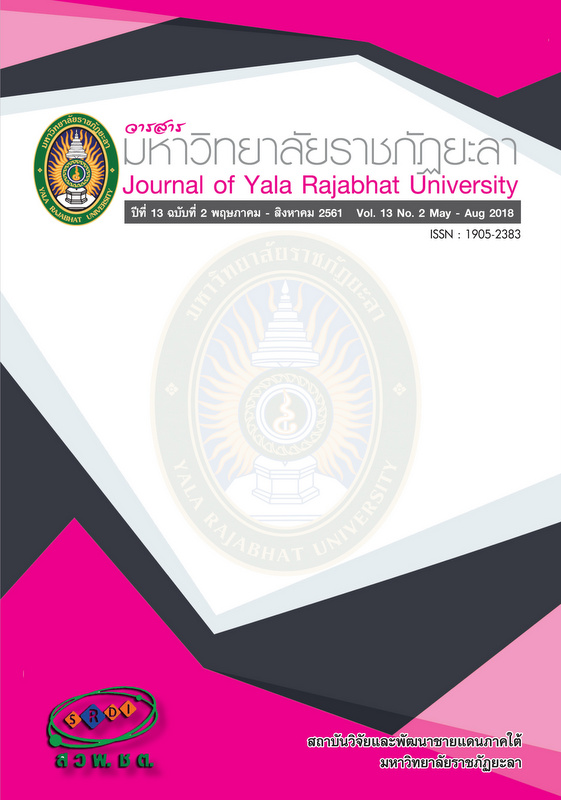รูปแบบการเรียนการสอนคณิตศาสตร์ที่ส่งเสริมการคิดแก้ปัญหาอย่างสร้างสรรค์
Main Article Content
บทคัดย่อ
การศึกษาครั้งนี้มีวัตถุประสงค์เพื่อศึกษาข้อมูลพื้นฐาน สภาพปัจจุบัน เงื่อนไขการจัดการเรียนการสอนคณิตศาสตร์และพัฒนารูปแบบการเรียนการสอนคณิตศาสตร์ที่ส่งเสริมการคิดแก้ปัญหาอย่างสร้างสรรค์ของนักเรียนชั้นมัธยมศึกษาปีที่ 5 โดยผู้วิจัยได้ทำการสังเคราะห์แนวคิด Treffinger และสัมภาษณ์ผู้ทรงคุณวุฒิทางด้านการศึกษา จำนวน 5 ท่าน ผลการวิจัยพบว่า รูปแบบการเรียนการสอนดังกล่าว ประกอบด้วย 6 องค์ประกอบ คือ แนวคิดและทฤษฎีพื้นฐาน วัตถุประสงค์ของรูปแบบ ขั้นตอนการจัดกิจกรรม ระบบสังคม หลักการตอบสนอง และระบบสนับสนุน ขั้นตอนการจัดกิจกรรมมี 3 ขั้นตอน ได้แก่ การค้นหา (S: Seeking) ปัญหาหรือเป้าหมายในการแก้ปัญหา ข้อมูล แนวคิดในการแก้ปัญหา การปฏิบัติ (A: Acting) แก้ปัญหา และการประยุกต์ใช้ (I: Implicating) ผลการประเมินความเหมาะสมของรูปแบบอยู่ในระดับมากที่สุด
Article Details
บทความ ข้อมูล เนื้อหา รูปภาพ ฯลฯ ที่ได้รับการเผยแพร่ในวารสารมหาวิทยาลัยราชภัฏยะลานี้ ถือเป็นลิขสิทธิ์ของวารสารมหาวิทยาลัยราชภัฏยะลา หากบุคคลหรือหน่วยงานใดต้องการนำทั้งหมดหรือส่วนหนึ่งส่วนใดไปเผยแพร่ต่อหรือกระทำการใดๆ จะต้องได้รับอนุญาตเป็นลายลักษณ์อักษรจากวารสารมหาวิทยาลัยราชภัฏยะลาก่อนเท่านั้น
เอกสารอ้างอิง
2.Cheausuwantavee, C. & Nillapun, M. (2013). The Development of Mathematics Instructional Model to Enhance Higher Order Thinking and Habits of Mind of Secondary School Students. Silpakorn Educational Research Journal, 5(2), 100-102. (in Thai)
3.Cojorn, K., Haemaprasith, S., Koocharoenpisal, N. & Siripankaew, P. (2011). A Development of the Creative Problem Solving (CPS) Learning Model on Matter and Propertics of Matter for Seventh Grade Students. KKU Research Journal, 1(2), 1-20. (in Thai)
4.Halmos, P. (2003).The heart of mathematics. American Mathematical Monthly, 87(7), 519-524.
5.Joyce, B., Weil, M. & Calhoun, E. (2011). Models of Teaching. Boston MA: Pearson Education, Inc.
6.Kunaruk, K. (2009). Instructional Design. (3rd ed.). Nakhonpatom: Silpakorn University. (in Thai)
7.Laoriandee, W. (2011). Thinking skills instructional models and strategies. (8th ed.). Nakhonpatom: Silpakorn University. (in Thai)
8.Makanong, A. (2003). Mathematics: Instruction and Learning. Bangkok: Textbook and Academic Document Center of the Faculty of Education, Chulalongkorn University. (in Thai)
9.Ministry of Education. (2009). Core Basic Curriculum B.E. 2551. Bangkok: Thai Chumnumkasetakorn printing. (in Thai)
10.Mitchell, W. E. & Konalik, T. F. (1999). Creative Problem Solving. n.p.: Unpublished.
11.Panich, W. (2013). How to Learn?. Bangkok: Siam Kaummajon. (in Thai)
12.Prachagool, V. & Nuangchalerm, P. (2016). Instructional Model. (3rd ed.). Khon Kaen: Klungnana.(in Thai)
Reys, R. E., Lindquuist, M. M., Lambdin, D. V., Smith, L. N. & Suydam, M. N. (2003). Helping
Children Learn Mathematics. New York: John Wiley & Sons.
Schoenfeld, A. H. (1992). Learning to think mathematically: Problem solving metacognition, and
sense-making in mathematics. In D. Grouws (ED.), Handbook for Research on
Mathematics Teaching and Learning. New York : MacMillan.
The Institute for the Promotion of Teaching Science and Technology. (2008). Mathematical Process
Skills. (2nd ed.). Bangkok: S. Charoenkarnpim. (in Thai)
The Institute for the Promotion of Teaching Science and Technology. (2012). Professional
Mathematics Teachers to Success. Bangkok: 3-Q Media. (in Thai)
Tonsuwanrat, O. (2009). Effects of Organizing Mathematics Learning Activities Using Creative
Problem Solving Ability and Creative Thinking of Eight Grade Students. M.Ed. Master
Thesis. Chulalongkorn University. (in Thai)
Treffinger, D. J. (2008). A New Renaissance ? Preparing Productive Thinkers for Tomorrow’s
World. Creative Learning Today, 15(4), 1.
Treffinger, D. J., S. G. Isaksen. & K. B. Dorvol. (2005). Creative Problem Solving (CPS Version
6.1TM) A Contemporary Framwork for Managing Change. Sarasofa: Center for Creative
Learning and Creative Problem Solving Group.
Treffinger, D. J. (1995). Creative Problem Solving: Overview of Educational Implications.
Educational Psychology Review, 7(3), 301-302.
Worapun, W., Nuangchalerm, P. & Marasri, M. (2016). Self-directed Learning Model in Physics
for High School Students. Journal of Yala Rajabhat University, 11(2), 31-46. (in Thai)


